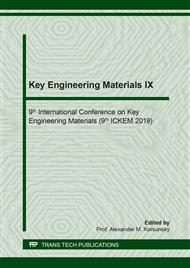[1]
B. Donald M., P. Tengvall, M. Textor, T. Peter, Titanium in Medicine, Springer-Verlag Berlin Heidelberg, (2001).
Google Scholar
[2]
A.T. Sidambe, Biocompatibility of advanced manufactured titanium implants-A review, Materials. 7 (2014) 8168–8188.
DOI: 10.3390/ma7128168
Google Scholar
[3]
R.R. Boyer, An overview on the use of titanium in the aerospace industry, Materials Science and Engineering A. 213 (1996) 103–114.
Google Scholar
[4]
D.A.X. Chu, S.L. Yang, Y. Jun, Hot Tensile Behaviors and Microstructure Evolution of Ti-6Al-4V Titanium Alloy Under Electropulsing, Acta Metallurgica Sinica (English Letters). 3 (2018) 1287–1296.
DOI: 10.1007/s40195-018-0735-3
Google Scholar
[5]
D.F. Gibbons, Biocompatibility of Macor glass ceramic, Journal of Biomedical Materials Research. 14 (1980) 177–180.
DOI: 10.1002/jbm.820140209
Google Scholar
[6]
Trevor, Application of Macor in the Aerospace Sector, Multi-Lab. (2016) 2. http://www.multi-lab.co.uk/blog/applications-macor-aerospace-sector-2/ (accessed February 13, 2018).
Google Scholar
[7]
A. Tomsia, A.T. Ceramic, D.P. Iv, Ceramic / metal joining for structures and materials, Journal De Physique IV. 03 (1993) 1317–1326.
DOI: 10.1051/jp4:19937203
Google Scholar
[8]
Y.J. Zhu, W.F. Ding, Z.Y. Zhao, Y.C. Fu, H.H. Su, Compressive strength and interface microstructure of PCBN grains brazed with high-frequency induction heating method, Acta Metallurgica Sinica (English Letters). 30 (2017) 641–649.
DOI: 10.1007/s40195-017-0570-y
Google Scholar
[9]
L.A. Rocha, M.A. Barbosa, R. Puers, Active metal brazing for joining glass-ceramic to titanium-a study on silver enrichment, Journal of Materials Science: Materials in Medicine. 6 (1995) 835–838.
DOI: 10.1007/bf00134327
Google Scholar
[10]
A. Guedes, A. Pinto, M. Vieira, F. Viana, Effect of brazing temperature on the titanium/glass-ceramic bonding, Journal of Materials Processing Technology. 92-93 (1999) 102–106.
DOI: 10.1016/s0924-0136(99)00240-x
Google Scholar
[11]
A. Guedes, A. Pinto, M. Vieira, Multilayered interface in Ti / Macor ® machinable glass-ceramic joints, Materials Science and Engineering A. 301 (2001) 118–124.
DOI: 10.1016/s0921-5093(00)01804-9
Google Scholar
[12]
E. Ariza, L.A. Rocha, Evaluation of corrosion resistance of multi-layered Ti/glass-ceramic interfaces by electrochemical impedance spectroscopy, Materials Science Forum. 492-493 (2005) 189–194.
DOI: 10.4028/www.scientific.net/msf.492-493.189
Google Scholar
[13]
L.A. Rocha, T.O. Ferreira, A.C. Monteiro, Corrosion Behaviour of Metal/Ceramic Interfaces in Physiological Solutions, Key Engineering Materials. 230-232 (2005) 1–4.
DOI: 10.4028/www.scientific.net/kem.230-232.479
Google Scholar
[14]
H.B. Liu, L.X. Zhang, L.Z. Wu, D. Liu, J.C. Feng, Vacuum brazing of SiO2 glass ceramic and Ti-6Al-4V alloy using AgCuTi filler foil, Materials Science and Engineering A. 498 (2008) 321–326.
DOI: 10.1016/j.msea.2008.08.008
Google Scholar
[15]
H.B. Liu, L.X. Zhang, D. Liu, P. He, J.C. Feng, Interface microstructure analysis of SiO2 glass ceramic and Ti-6Al-4V alloy joint brazed with Ti-Zr-Ni-Cu alloy, Materials Science and Technology. 26 (2010) 188–192.
DOI: 10.1179/174328409x428891
Google Scholar
[16]
D. Lewis, R. Bruce, M. Imam, A. Fliflet, Joining of materials with millimetre-wave beam source, Science and Technology of Welding & Joining. 9 (2004) 459–464.
DOI: 10.1179/136217104225021706
Google Scholar
[17]
C. van der Eijk, Z.K. Sallom, O.M. Akselsen, Microwave brazing of NiTi shape memory alloy with Ag–Ti and Ag–Cu–Ti alloys, Scripta Materialia. 58 (2008) 779–781.
DOI: 10.1016/j.scriptamat.2007.12.017
Google Scholar
[18]
S. Tamang, S. Aravindan, An investigation on joining of Al6061-T6 to AZ31B by microwave hybrid heating using active braze alloy as an interlayer, Journal of Manufacturing Processes. 28 (2017) 94–100.
DOI: 10.1016/j.jmapro.2017.05.027
Google Scholar
[19]
C. V. Thompson, Solid-State Dewetting of Thin Films, Annual Review of Materials Research. 42 (2012) 399–434.
DOI: 10.1146/annurev-matsci-070511-155048
Google Scholar
[20]
A. Goswami, S. Aravindan, P. V. Rao, Fabrication of substrate supported bimetallic nanoparticles and their optical characterization through reflection spectra, Superlattices and Microstructures. 91 (2016) 252–258.
DOI: 10.1016/j.spmi.2016.01.016
Google Scholar
[21]
J.-Y. Kwon, T.-S. Yoon, K.-B. Kim, S.-H. Min, Comparison of the agglomeration behavior of Au and Cu films sputter deposited on silicon dioxide, Journal of Applied Physics. 93 (2003) 3270–3278.
DOI: 10.1063/1.1556178
Google Scholar
[22]
N. Wakabayashi, M. Ai, K. Iijima, Y. Takada, O. Okuno, Infrared Gold Allov Brazing on Titanium and Ti-GA1-4V Alloy Surfaces and its Application to Removable Prosthodontics, Journal of Prosthodontics. 8 (1999) 180–187.
DOI: 10.1111/j.1532-849x.1999.tb00033.x
Google Scholar
[23]
X. Sun, G. Wu, J. Yu, C. Du, Efficient microwave welding of polypropylene using graphite coating as primers, Materials Letters. 220 (2018) 245–248.
DOI: 10.1016/j.matlet.2018.03.046
Google Scholar
[24]
A. Kosinova, L. Klinger, O. Kovalenko, E. Rabkin, The role of grain boundary sliding in solid-state dewetting of thin polycrystalline films, Scripta Materialia. 82 (2014) 33–36.
DOI: 10.1016/j.scriptamat.2014.03.015
Google Scholar
[25]
N. Yoshikawa, E. Ishizuka, S. Taniguchi, Heating of Metal Particles in a Single-Mode Microwave Applicator, Materials Transactions. 47 (2006) 898–902.
DOI: 10.2320/matertrans.47.898
Google Scholar
[26]
R.M. Anklekar, K. Bauer, D.K. Agrawal, R. Roy, Improved mechanical properties and microstructural development of microwave sintered copper and nickel steel PM parts, Powder Metallurgy. 48 (2005) 39–46.
DOI: 10.1179/003258905x37657
Google Scholar
[27]
V.K. Varadan, V. V Varadan, Microwave Joining and Repair of Composite Materials, Polymer Engineering and SciencePloymer. 31 (1991) 470–486.
DOI: 10.1002/pen.760310703
Google Scholar
[28]
D. Demirskyi, D. Agrawal, A. Ragulya, Neck growth kinetics during microwave sintering of nickel powder, Journal of Alloys and Compounds. 509 (2011) 1790–1795.
DOI: 10.1016/j.jallcom.2010.10.042
Google Scholar
[29]
M. Kikuchi, M. Takahashi, O. Okuno, Elastic moduli of cast Ti-Au, Ti-Ag, and Ti-Cu alloys, Dental Materials. 22 (2006) 641–646.
DOI: 10.1016/j.dental.2005.05.015
Google Scholar
[30]
H. Baker, Alloy Phase Diagrams, (1998).
Google Scholar


